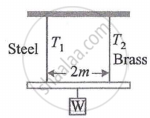Advertisements
Advertisements
प्रश्न
Define linear S.H.M.
उत्तर
Linear S.H.M. is defined as the linear periodic motion of a body, in which force (or acceleration) is always directed towards the mean position and its magnitude is proportional to the displacement from the mean position.
संबंधित प्रश्न
Show that a linear S.H.M. is the projection of a U.C.M. along any of its diameter.
Define linear simple harmonic motion.
Choose the correct option:
A body of mass 1 kg is performing linear S.H.M. Its displacement x (cm) at t(second) is given by x = 6 sin `(100t + π/4)`. Maximum kinetic energy of the body is ______.
Two parallel S.H.M.s represented by `"x"_1 = 5 sin(4π"t" + π//3)` cm and `"x"_2 = 3sin (4π"t" + π//4)` cm are superposed on a particle. Determine the amplitude and epoch of the resultant S.H.M.
What does the phase of π/2 indicate in linear S.H.M.?
The equation of a simple harmonic motion is given by, x = 8 sin (8πt) + 6 cos (8πt), the initial phase angle is ______
A particle is performing a linear simple harmonic motion of amplitude 'A'. When it is midway between its mean and extreme position, the magnitudes of its velocity and acceleration are equal. What is the periodic time of the motion?
A particle is executing simple harmonic motion with frequency f. The frequency at which its kinetic energy changes into potential energy is ______.
A simple pendulum performs simple harmonic motion about x = 0 with an amplitude A and time period T. The speed of the pendulum at x =A/2 will be ____________.
A particle executes simple harmonic motion with amplitude 'A' and period 'T'. If it is halfway between mean position and extreme position, then its speed at that point is ______.
The equation of a particle executing simple harmonic motion is given by x = sin π `("t" + 1/3)` m. At t = 1s, the speed of particle will be ______. (Given π = 3.14)
Two simple harmonic motions are represented by the equations y1 = 0.1 sin `(100pi"t"+pi/3)` and y1 = 0.1 cos πt.
The phase difference of the velocity of particle 1 with respect to the velocity of particle 2 is ______.
A particle is executing simple harmonic motion with amplitude A. When the ratio of its kinetic energy to the potential energy is `1/4`, its displacement from its mean position is ______.
For a particle executing SHM the displacement x is given by x = A cos ωt. Identify the graph which represents the variation of potential energy (P.E.) as a function of time t and displacement x.


A light rod of length 2m suspended from the ceiling horizontally by means of two vertical wires of equal length. A weight W is hung from a light rod as shown in figure.

The rod hung by means of a steel wire of cross-sectional area A1 = 0.1 cm2 and brass wire of cross-sectional area A2 = 0.2 cm2. To have equal stress in both wires, T1/T2 = ______.
For a particle performing linear S.H.M., its average speed over one oscillation is ______. (a = amplitude of S.H.M., n = frequency of oscillation)
If a body is executing simple harmonic motion, then ______.
Two simple harmonic motion are represented by the equations, y1 = 10 sin `(3pi"t"+pi/4)` and y2 = 5`(3sin3pi"t"+sqrt3cos3pi"t")`. Their amplitudes are in the ratio of ______.
What do you know about restoring force?
The displacement of a particle performing simple harmonic motion is `1/3` rd of its amplitude. What fraction of total energy will be its kinetic energy?
